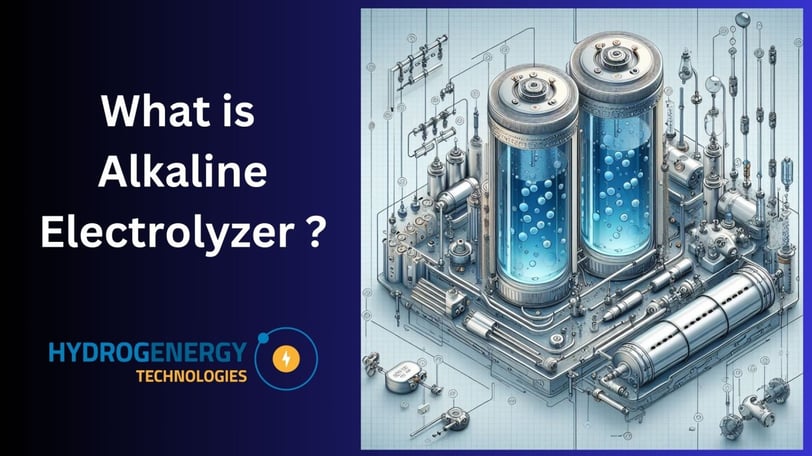What is Alkaline Electrolyzer?
Discover the role of alkaline electrolyzers in green hydrogen technology. Advantages | Disadvantages | Current Scenario | Future Prospects
ELECTROLYZER


The Role of Alkaline Electrolyzers in Green Hydrogen Technology
Introduction
As we look for cleaner and more sustainable energy sources, green hydrogen has emerged as a front-runner. Produced by splitting water into hydrogen and oxygen using renewable energy, green hydrogen offers a zero-emission alternative to traditional fossil fuels. Alkaline electrolyzers are one of the key technologies enabling this process. In this blog, we’ll explore what alkaline electrolyzers are, why they’re important, their benefits and drawbacks, and what the future holds for them in the green hydrogen landscape.
Understanding Alkaline Electrolyzers
What Are Alkaline Electrolyzers?
Think of an alkaline electrolyzer as a sophisticated machine that takes in water and electricity and produces hydrogen and oxygen gases. Here’s how it works in simple terms:
Electrolyte Solution: The machine uses an alkaline solution (like a strong soap) made of potassium hydroxide (KOH) or sodium hydroxide (NaOH). This solution helps carry the electric current between two key parts called electrodes.
Electrodes: These are like special plates, usually made of nickel or stainless steel, where the magic happens. One plate (anode) attracts the negative parts of water molecules, and the other (cathode) attracts the positive parts.
Splitting Water: When electricity passes through the solution, it splits water molecules into hydrogen and oxygen. The hydrogen gathers at the cathode, and the oxygen at the anode.
Adoption of Alkaline Electrolyzers
A Brief History and Current Use
Alkaline electrolyzers have been around for a long time, dating back to the early 1900s. They’re known for being reliable and cost-effective, which is why industries like fertilizers, chemicals, and oil refining have used them for years to produce hydrogen.
Modern Green Hydrogen Applications
Today, with the world focusing more on renewable energy, alkaline electrolyzers are being adopted for producing green hydrogen. Countries like Germany, Japan, and Australia are investing in large-scale projects to use these electrolyzers for making hydrogen from renewable electricity. This hydrogen can then be used for everything from powering cars to heating homes.
Advantages of Alkaline Electrolyzers
Proven Technology: They’ve been used for decades, so we know they work well and last a long time.
Affordable: Compared to other types like PEM (Proton Exchange Membrane) electrolyzers, alkaline electrolyzers are generally cheaper to make and operate.
Large-Scale Production: They’re great for big projects because they can produce large amounts of hydrogen.
Durable: The materials used are tough and can handle the harsh alkaline environment, which means they don’t need to be replaced often.
Disadvantages of Alkaline Electrolyzers
Efficiency: They aren’t as efficient as some newer technologies, meaning they use more electricity to produce the same amount of hydrogen.
Wear and Tear: Over time, the parts can wear out because of the strong alkaline solution, leading to maintenance costs.
Purity Issues: The hydrogen produced can have impurities, requiring extra steps to clean it up if high purity is needed.
Slow to Start: They take longer to start up and respond to changes, making them less ideal for applications that need quick adjustments.
Current Scenario
Market Trends
The market for alkaline electrolyzers is growing fast, driven by the increasing demand for green hydrogen. Big companies like Nel Hydrogen, Thyssenkrupp, and McPhy are expanding their production to keep up with this demand. Governments and private investors are pouring money into green hydrogen projects worldwide.
Technological Improvements
There are exciting advancements in the field, such as new materials for electrodes that last longer and are more efficient. Engineers are also developing better systems for integrating these electrolyzers with renewable energy sources like wind and solar power.
Supportive Policies
Governments are helping too, with policies that offer financial incentives like subsidies and tax breaks for green hydrogen projects. These policies make it easier for companies to invest in and adopt alkaline electrolyzers.
Future Prospects
Technological Advancements
The future looks bright for alkaline electrolyzers, with ongoing research focused on making them even better. Key areas include:
Boosting Efficiency: Scientists are working on new materials and designs to make the process more energy-efficient.
Increasing Durability: Research into tougher materials that can withstand the alkaline environment for longer periods is underway.
Integration with Renewables: Enhancing the compatibility of these electrolyzers with renewable energy sources to handle fluctuations in energy supply.
Market Growth
The global green hydrogen market is set to expand rapidly, with alkaline electrolyzers playing a key role. Key drivers include:
Climate Goals: Countries are setting ambitious targets to reduce carbon emissions, and green hydrogen is a crucial part of these plans.
Renewable Energy Storage: Using excess renewable electricity to produce hydrogen can help balance the grid and store energy for later use.
Building a Hydrogen Economy: The development of a global hydrogen economy for transportation, industry, and energy storage will boost demand for hydrogen production technologies.
Challenges and Opportunities
Despite the positive outlook, there are challenges to overcome:
Cost Reduction: Continuous efforts are needed to bring down the costs of producing and operating alkaline electrolyzers.
Infrastructure: Developing the infrastructure for hydrogen production, storage, and distribution is essential.
Policy Support: Consistent and strong policy support will be crucial to foster investment and innovation.
Public Awareness: Educating the public about the benefits of green hydrogen and addressing safety concerns is vital for wider acceptance.
Conclusion
Alkaline electrolyzers are a cornerstone technology in the journey towards a sustainable energy future. They offer a mature, cost-effective, and scalable solution for producing green hydrogen. While there are challenges to address, the ongoing advancements and supportive market conditions paint a promising picture. As the world shifts towards cleaner energy, alkaline electrolyzers will play a critical role in enabling the widespread adoption of green hydrogen, paving the way for a cleaner, greener, and more sustainable future.
View our product page to purchase Fuel Cells, Electrolyzers and other hydrogen related equipment.
